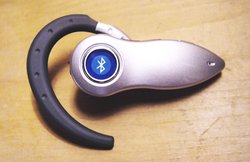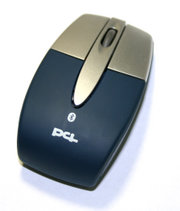Bluetooth
Bluetooth is an industrial specification for wireless personal area networks (PANs). more...
Bluetooth provides a way to connect and exchange information between devices like personal digital assistants (PDAs), mobile phones, laptops, PCs, printers and digital cameras via a secure, low-cost, globally available short range radio frequency.
Introduction
Bluetooth is a radio standard primarily designed for low power consumption, with a short range (power class dependent: 10 centimetres, 10 metres, 100 metres or up to 400 metres , ) and with a low-cost transceiver microchip in each device.
Bluetooth lets these devices talk to each other when they come in range, even if they are not in the same room, as long as they are within up to 100 metres (328 feet) of each other, dependent on the power class of the product. Products are available in one of three power classes:
- Class 1 (100 mW) : It has the longest range at up to 100 metres (328 ft).
- Class 2 (2.5 mW) : It allows a quoted transmission distance of 10 metres (33 ft).
- Class 3 (1 mW) : It allows transmission of 10 cm (3.9 in), with a maximum of 1 metre (3.3 ft).
Bluetooth applications
- Wireless networking between desktops and laptops, or desktops in a confined space and where little bandwidth is required
- Bluetooth peripherals such as printers, mice and keyboards
- Bluetooth cell phones have been sold in large numbers, and are able to connect to computers, personal digital assistants (PDAs), and various handsfree devices. The standard also includes support for more powerful, longer-range devices suitable for constructing wireless LANs.
- Transfer of files (images, mp3s, etc) between mobile phones, Personal digital assistants (PDAs) and computers via OBEX
- Certain mp3 players and digital cameras to transfer files to and from computers
- Bluetooth headsets for mobile phones and smartphones
- Some testing equipment is bluetooth enabled
- Medical applications — Advanced Medical Electronics Corporation is working on several devices
- Certain GPS receivers transfer NMEA data via Bluetooth
- Bluetooth car kits — Acura, with the 2004 Acura TL, was the first motor vehicle manufacturer to install handsfree Bluetooth technology. Later, BMW added it as an option on its 3 Series, 5 Series, 7 Series and X5 vehicles. Since then, other manufacturers have followed suit, with many vehicles, including the 2004 Toyota Prius and the 2004 Lexus LS 430. The Bluetooth car kits allow users with Bluetooth-equipped cell phones to make use of some of the phone's features, such as making calls, while the phone itself can be left in a suitcase or in the boot/trunk, for instance. Companies like Parrot or Motorola manufacture Bluetooth hands-free car kits for well-known brand car manufacturers.
- Certain data logging equipment transmits data to a computer via Bluetooth.
- For remote controls where infrared was traditionally used.
- Hearing aids — Starkey Laboratories have created a device to plug into some hearing aids
Read more at Wikipedia.org




